
by Valley Gadfly | Mar 18, 2024 | Main Articles
Audit Finds City’s Public Courses Still Aren’t Up To Par; Parks & Recreation Cutbacks Increase Chances For Closures
by Glen Richardson

Wellshire Golf Clinic: Jack Nicklaus held a golf clinic on Wellshire’s driving range in 1977 in connection with Golf Digest Magazine.

Challenging Course: Kennedy Golf Course offers terrific views and challenging play at every skill level. Fairways and greens are difficult yet friendly.

Donald Ross Design: Wellshire Golf Course is the only public course West of the Mississippi that is a Donald Ross design.
Denver’s public golf courses’ distinctive locations — particularly the Wellshire Golf Course on S. Colorado Blvd. and the Kennedy Golf Course on E. Hampden Ave. — have made the Mile High City an all-seasons, outdoor-lover’s playground, and golf one of the city’s best ways to enjoy the outdoors.
In recent years, however, Denver Parks & Recreation — that runs the local courses — has become the number one enemy of the Valley’s local players, always a putt short of doing their job. Denver Auditor Timothy M. O’Brien, CPA, who has tried to caddie the staff managing local courses, again reports Denver’s public courses aren’t up to par.
Declining to improve customer experience for golfers, instead simply manipulating amenities and services to an ever-declining revenue stream, is threating to spiral local courses out of solvency.
Ignoring Action Plan
This year O’Brien’s approach shot has never been stronger: “I remain concerned about the future of city golf courses,” Auditor O’Brien declares.
To provide a better customer experience for golfers, Denver Golf — what O’Brien terms the Park & Rec group managing public courses — “should improve customer service, maximize revenue, update strategy documentation, improve its capital planning and financial monitoring.”
O’Brien says he is disappointed Denver Golf has chosen to disagree with strategy and action plan recommendations that would increase transparency, hold the Denver Golf enterprise more accountable to the city and public, and improve organizational efficiency and effectiveness, O’Brien explains.
Problems Persist
The auditor does say some Denver golf courses are looking better since the last time auditors assessed them, but the city still lacks a long-term plan to fix problems proactively and effectively. That’s according to a follow-up report released by Auditor O’Brien, showing partial improvement to golf course aesthetics and safety, but limited big-picture improvement due to managers’ disagreements with audit recommendations.
“Some of the rusty nails are gone, but the bigger problem remains,” Auditor O’Brien says. “I hope new leadership in the parks department will reconsider the value of making a plan for maintaining the city’s public golf courses for the benefit of all players.”
Our 2021 audit found safety and aesthetic issues at several city golf courses, such as exposed rusty nails and graffiti. We also found issues with the credit card system. We recommended managers take a big-picture look at addressing issues over time, rather than an ad-hoc response to maintenance and planning. “Unfortunately, they disagreed with all of our recommendations for a strategic plan. They called goals and timelines an unnecessary hinderance,” he relates.

Cool Complex: Kennedy Golf Course in Southeast Denver offers something for everyone, from a round of golf, to a range practice, or a game of putt-putt.
Only Applied Three
“Making a strategic plan and setting goals is management 101,” Auditor O’Brien notes. “It is both helpful and necessary if you want to use resources effectively and avoid leaving graffiti and safety hazards to sit for years at a time.”
Denver Golf managers fully implemented just three of our recommendations, partially implemented one, and did not implement five more. They disagreed with four others and took no action — those were related to strategic planning and documentation related to priorities and goals.
Notable improvements included several repairs at the Kennedy Golf Course: the clubhouse has been repainted and its molding fixed; dangerous storm shelters have been removed; the restaurant’s walls have been patched; old tables and rusting railings have been replaced; the damaged branch of a cottonwood tree on Hole 6 has been removed; cart paths have been repaved; and starter desks have been replaced. However, other issues Golf could have worked on include repairs at the Wellshire golf courses, which are still incomplete after three years. At Wellshire, we noted the bar and restroom near Hole 5 was not painted and now shows signs of possible structural damage.
Long Term Planning
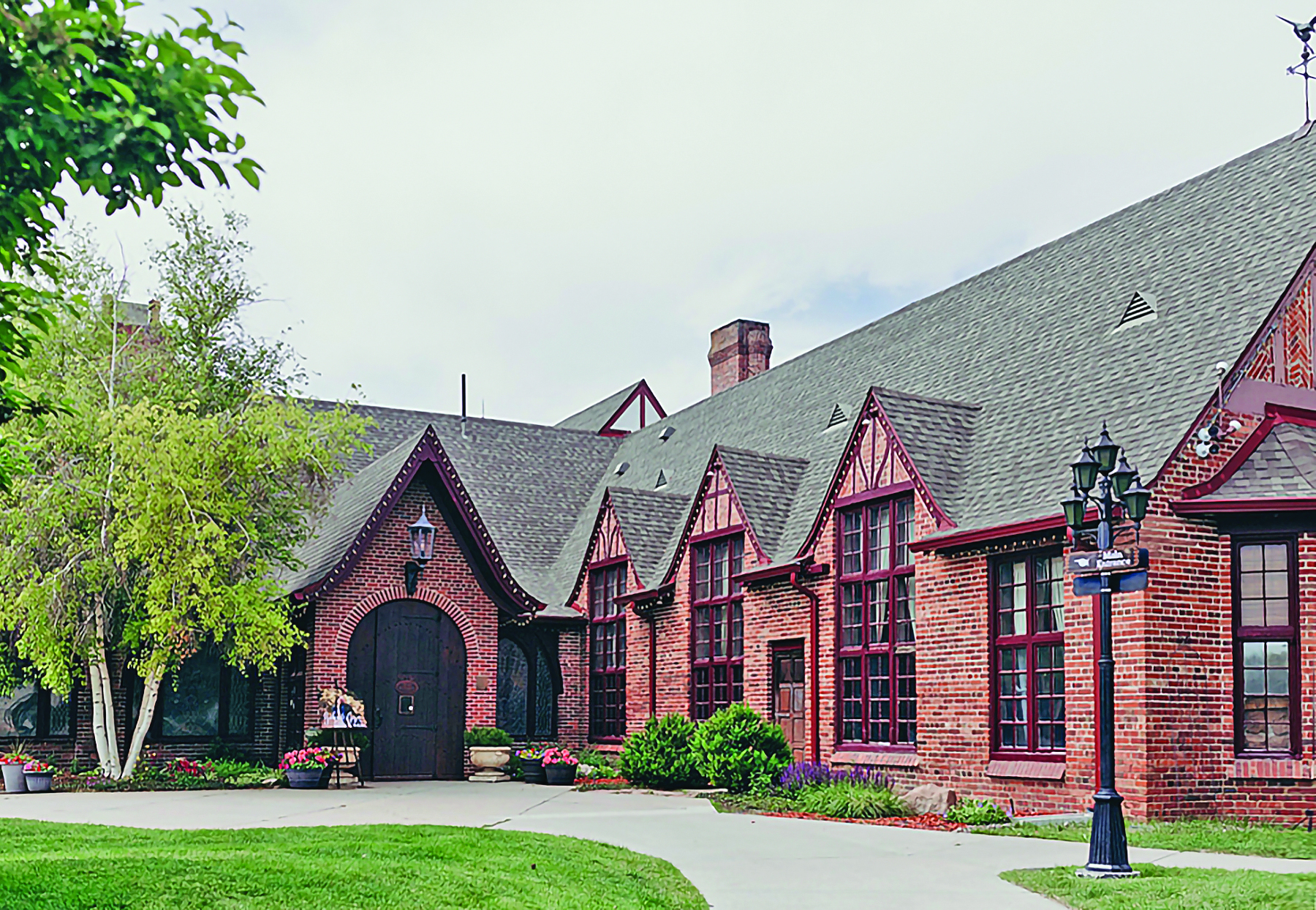
Wellshire Attraction: In recent years many say Wellshire’s Event Center has become a bigger attraction than golf.
“Strategic long-term planning could help address lengthy turnaround for important maintenance projects,” Auditor O’Brien believes. Denver Golf’s lack of a strategic plan and documented organizational priorities and goals may prevent it from proactively shaping the future of its operations and addressing challenges before they arise. “With a big-picture plan, managers could create timelines and schedules for course maintenance and avoid three-year waits for repairs.”
Golf managers did make some notable updates to their technology, improving golfer experience for bookings and check-in. By implementing some of our recommendations, Denver Golf made its member check-in and cashiering process quicker and easier for its customers. Denver Golf successfully eliminated duplicate accounts in the golfer loyalty database. It also integrated credit cards into its point-of-sale system and is now working with a new vendor.
Due to factors outside of its control, Golf still is not charging nonrefundable prebooking fees, possibly missing out on revenue when golfers do not show up for their tee times. But once issues with data protection for credit card transactions over the phone are resolved, we expect Golf to implement this recommended improvement.

by Laura Lieff | Mar 18, 2024 | Main Articles
by Laura Lieff
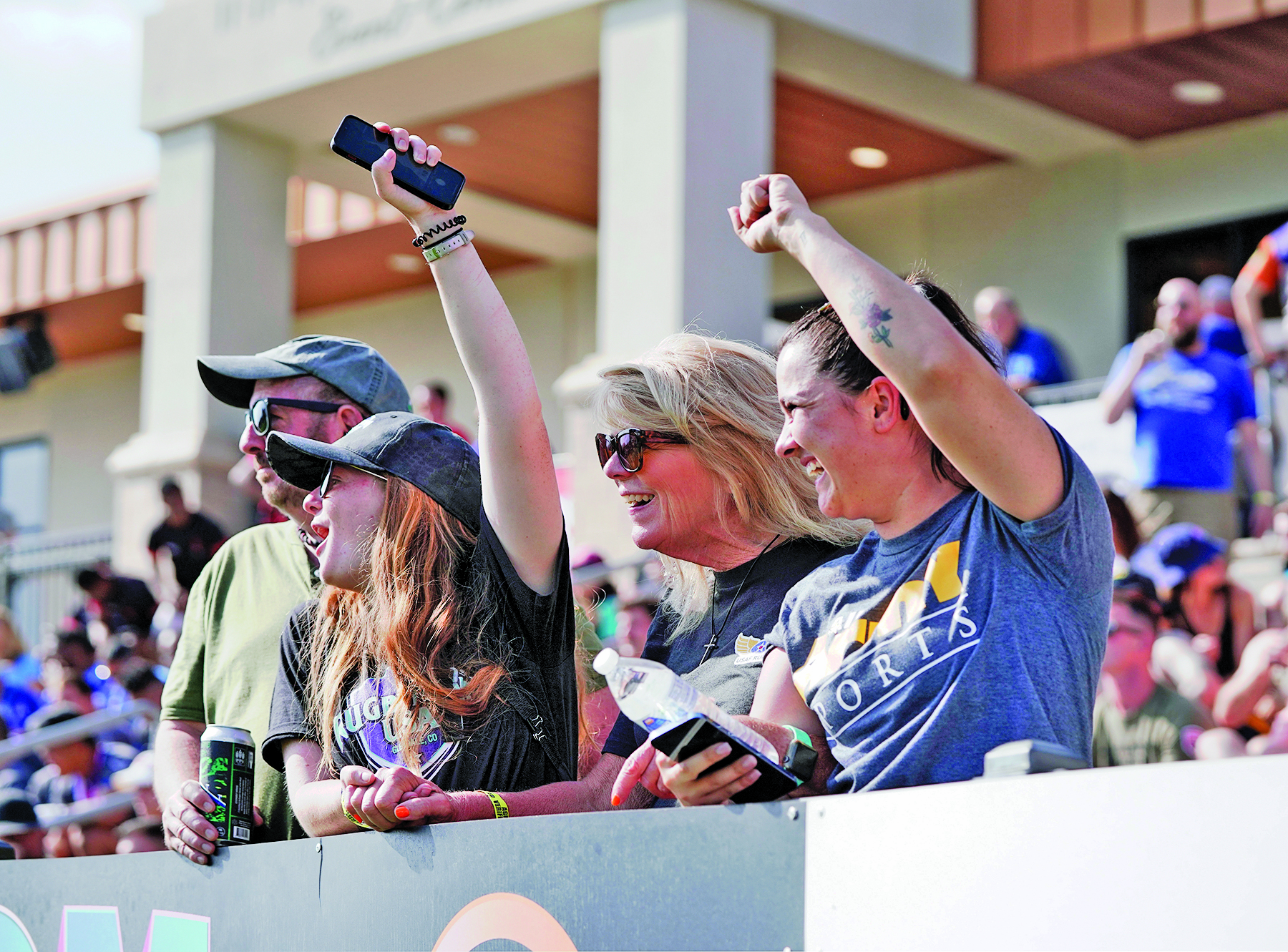
Home Team Support: Infinity Park has become a destination that people of all ages look forward to visiting as they enjoy cheering on their home team.
Since opening its gates in 2007, Infinity Park has welcomed tens of thousands of visitors. The first and only municipally-owned rugby-specific stadium in the United States, Infinity Park spans 16 acres (including an eight-acre green open space), features a state-of-the-art gym, a full-sized outdoor training pitch, and a stadium with a seating capacity of 4,000. It is also home to a recreation center and an event center, as well as the American Raptors rugby team.
Located in the heart of Glendale, Infinity Park was built on a bold vision to center the future of the city around the growing sport of rugby. Featuring a multi-purpose indoor/outdoor sports complex, Infinity Park has earned the designation of RugbyTown USA. Along with serving as the American Raptors’ headquarters, Infinity Park has hosted several different international men’s and women’s rugby matches including the 2008 North America 4, the 2009 and 2010 Churchill Cups, the 2009 Americas Rugby Championship, the 2019 Pacific Nations Cup, and all three 2023 Rugby World Cup Qualifiers for the United States men’s national rugby team. The venue was also the United States stop on the 2018- 2019 World Rugby Women’s Sevens Series and is home to the annual RugbyTown 7s tournament.
Local Destination
Beyond rugby, Infinity Park has become a destination that people of all ages look forward to visiting. “We see families, groups of friends, rugby fans, and community members who want to spend time outside and cheer on their home team on a beautiful weekend afternoon,” says Glendale City Manager Chuck Line. “Watching Infinity Park become the heart of our city has been very rewarding.”
Another aspect that sets Infinity Park apart is the local feel it brings to hosted events and provides for the community. Because of the park’s expansive space and Glendale’s welcoming mindset, local recreational leagues, youth leagues, and residents always have a place to practice and compete, gather and interact, or simply hang out.
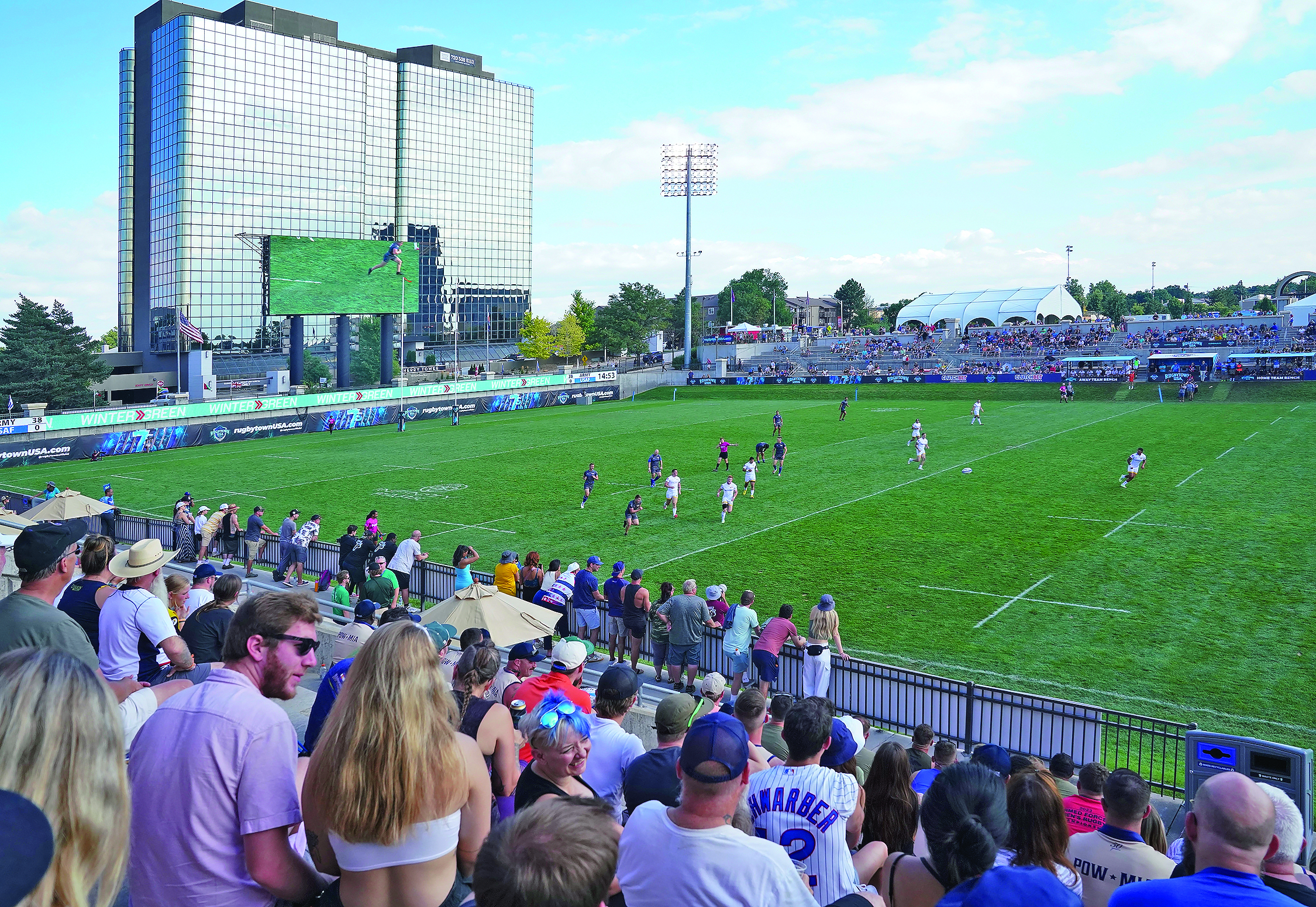
Local Destination: With a seating capacity of 4,000, Infinity Park continues to draw large crowds for all types of events.
“Infinity Park serves as an entertainment anchor for Glendale and offers the community and beyond the opportunity to enjoy sporting events, movies, and music,” says Director of Infinity Park Operations, Kieran Nelson. “Also, since its inception, the park has garnered a reputation among the international rugby community as a world-class venue, and we could not be prouder to have earned that distinction.”
In addition to the family-friendly environment and welcoming staff, spending time at Infinity Park is affordable as adult tickets for rugby games are $10 and admission for kids 12 and under is free. This spring, Glendale residents are looking forward to watching their home team return from South America to play in the professional SRA league.
Upcoming games will feature the following theme days:
April 7
For Military Appreciation Day, Glendale will show gratitude to our armed forces by offering camo koozies at the gate and opportunities to engage with various on-site military branches. Additionally, fans can nominate a hero to be honored during the match, making it a day to celebrate and recognize our military heroes.
April 14
In recognition of Mental Health Awareness Day, Infinity Park is partnering with Howzit — a mental health awareness brand founded by former rugby players — by offering a gate giveaway of stress balls. Engage with representatives from All Health Network, the Glendale Police Department, and Canine Partners of the Rockies, as Glendale promotes mental well-being and support within the community.
April 21

Social Spot: Spending a spring afternoon outside socializing with friends has become part of the park’s legacy.
Celebrate Colorado Day at Infinity Park with exciting promotions including a complimentary American Raptors Colorado keychain, opportunities to interact with mascots from local college and sports teams, and delicious Colorado-themed food from our on-site food trucks, among other festivities.
April 28
For Autism Awareness Day, Firefly Autism will provide valuable resources and information at Infinity Park. Receive a complimentary fidget spinner at the gate, and meet the adorable service dogs in training from Canine Partners of the Rockies. There will also be a quiet room for those needing a sensory break. Additionally, thanks to KultureCity, sensory bags will be available at all Infinity Park events, ensuring inclusivity and support for individuals with sensory sensitivities.
More events happening this summer include:
May 11: 2024 High School Boys and Girls Rugby Championships
June 10: Movie Night — Teenage Mutant Ninja Turtles: Mutant Mayhem
June 24: Movie Night — The Marvels
July 2: Glendale Fireworks
July 8: Movie Night — Trolls Band Together
July 22: Movie Night — Barbie
August 23-25: RugbyTown 7s
For more information, or to view the Raptors’ schedule and ticket information, visit www.americanraptors.com/schedule-and-tickets.

by Valley Gadfly | Feb 19, 2024 | Main Articles
District’s First Ever Data Driven Study Of BID’s Growth Exposes Rising Congestion, Slowing Business, And Declining Quality Of Life
by Glen Richardson
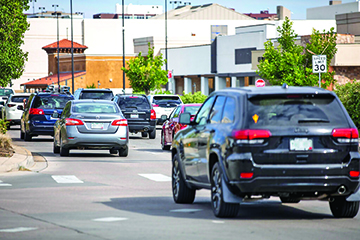
Creek Car Congestion: District’s growth has had biggest impact at 1st Ave. & University. New Cherry Creek West project will worsen traffic problem, BID’s data analysis forewarns. Photo by Kevin J. Beaty/Denverite
One of the most dynamic business and residential areas in the Mile High City, development in Cherry Creek North has exceeded the 10-year forecast. The attraction of businesses and their office space needs, moreover, is accelerating the desire of certain businesses to relocate to the district from other areas of the city.
With the impressive growth has come traffic congestion, parking, and transportation problems. The first ever data driven analysis of the Business Improvement District’s (BID) actual growth and development since 2012 has just been released. Study is being distributed to various RNO’s, neighborhood organizations, plus city agencies. Those with comments and concerns should contact their city councilman.
The analysis is the mastermind of retired longtime Cherry Creek resident volunteers David Steel, former President of Western Development Group; and Wayne New, former Denver District 10 City Councilman. The pair piloted the study because they care about the community and want to maintain the quality of life and success that all businesses and residents now enjoy. Furthermore, the business-residential leaders have more than 40 years of real estate experience in the U.S., Canada, and Europe.
Creek Data Analysis
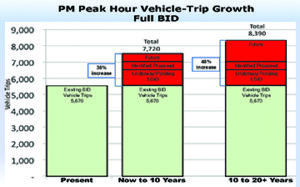 Cherry Creek North’s growth has had the greatest traffic effect on 1st Ave., University, and surrounding neighborhood streets. The
Cherry Creek North’s growth has had the greatest traffic effect on 1st Ave., University, and surrounding neighborhood streets. The
Steel-New data analysis of the district emphasizes that fact and is key to recommendations they are making. Bottom line: The more difficult it becomes to move around the district, the less appealing it will become.
Albeit the pending Cherry Creek West development is planned on Cherry Creek Shopping Center property, it will have a significant impact on 1st Ave. traffic and its efficient movement through Cherry Creek.
The proposed 1,918,170-sq.-ft. development will create the highest grouping of high-rise buildings in the Cherry Creek area. More important to 1st Ave., the seven-building development will create 1,922 vehicle trips during the evening (PM) peak hour. That’s at an intersection that has already reached its maximum vehicle capacity according to traffic standards.
Building Toward Gridlock

West End Traffic Trap: Despite being on Cherry Creek Shopping Center property, massive Cherry Creek West project will add to gridlock at the 1st Ave. & University intersection.
Cherry Creek West development vehicle trips will only add to the present 1st Ave. traffic movement problems. In addition, the East West Partner’s Large Development framework document estimates that 3,000 new jobs will be added, increasing the vehicle trip counts.
Using the 2013 national standard ratios to calculate Cherry Creek West vehicle trips per evening (PM) peak hour, the number of vehicle trips was determined to be 1,922 trips for all three building uses.
Three of the seven proposed buildings will be devoted to residential use and will be required to abide by the City’s affordable housing requirements, which would reserve 10% of the units for low to moderate income households. The framework description lists the residential buildings as having 598 units.
Project Cutback Proposed
To reduce the traffic impact from Cherry Creek West, the study recommends the following changes to the development plans:
Reduce the building heights from the proposed 12-13-stories to 8-stories, which would be consistent with Cherry Creek BID Zoning. Change the numbers of proposed office buildings from four to three, and change the number of proposed residential buildings from three to four.
Since community residential space is needed more due to the number of existing and new office space developments, new mixed-use development should emphasize residential use. Increasing the residential square-footage will have a dramatic reduction in traffic volumes generated by the project. The vehicle trip standard for office use is approximately three-times the standard for residential use, and the standard for retail use is five-times the level of residential traffic trips. An estimated 713 traffic trips per evening (PM) peak hour should assist in lessening the traffic impact on 1st Ave. and University.
Parking-Valet Service
Additionally, the study urges the continued support of Cherry Creek North’s BID Zoning. The pair say the 2014 rezoning process was a productive, cooperative process that greatly enhanced the previous BID zoning to allow and promote greater development within its boundaries. They emphasize, however, that it is important to recognize the rezoning requirement be maintained in order to minimize future growth and mobility problems.
Short term, the value of a BID Parking Benefit District should be studied. Such a district would tie the economic benefits of performance parking directly to improving the quality of life in the immediate area. Residents and businesses are more receptive to such a district as the revenues are reinvested in the neighborhood. Additionally, the value of a Parking Benefit District should be considered. They reduce traffic congestion while increasing local sales tax revenue.
With parking difficulties identified in Denver Moves Cherry Creek as a major problem, Steel and New also suggest a centralized BID area for a paid valet service should be organized and tested. It would provide a convenient one-stop spot for customers and residents using cars to park and shop in Cherry Creek. They also believe the 2013 Development & Traffic Study be maintained on a timely basis to project future growth and needs accurately. Lastly, they urge a professional planner-traffic engineer be engaged by BID to update the study.
Clayton-Sears Site
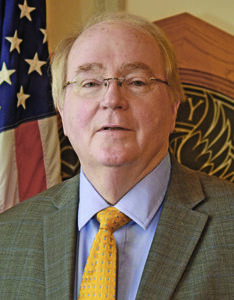
District Data Duo: First ever data driven analysis of BID’s growth was created by longtime resident volunteers. They are from left, David Steel, former President of Western Development Group, and Wayne New, former Denver District 10 City Councilman.
 The Clayton-Sears development — the other Cherry Creek west-end development about to begin construction — is also expected to impact 1st Ave. traffic.
The Clayton-Sears development — the other Cherry Creek west-end development about to begin construction — is also expected to impact 1st Ave. traffic.
The site will feature 126,000-sq.-ft. of new four-story buildings plus ground floor retail space. An 867,000-sq.-ft. eight-story apartment building with 25 residential condominiums is planned above the existing Clayton parking garage.
Vehicle trip counts and traffic flow for the Clayton-Sears development will also have impact on 1st Ave. traffic flow. The project, moreover, will impact traffic on 2nd Ave., Columbine Street, and Clayton Lane. Fortunately, a large percentage of the project is devoted to residential use which produces fewer vehicle trips than retail uses.
Intersection Gridlock
How busy is the University Blvd. and 1st Ave. intersection? The Denver Regional Council of Governments (DRCOG) says it averages more than 50,000 vehicles every day. Moreover, DRCOG says the stretch of University Blvd. just south of 1st Ave. tallies more than 45,000 cars daily.
Overwhelmed by the traffic, commuters driving through the intersection contacted Denver7 Traffic Expert Jayson Luber in Sept. of 2023. The intersection traffic was “driving them crazy,” they told the reporter who has been with Denver7 since 2006 and reported traffic for KOA Radio prior to that.
The intersection supports cars traveling in multiple directions, Luber was told by the Denver Department of Transportation & Infrastructure (DOTI). Cars going through the intersection are turning in multiple directions and must also provide time for people to safely cross on foot, all in about the span of two minutes. Moreover, they emphasized the two minutes is divvied up between all the different movements at the intersection. The morning light timing, the city told Luber, is designed to allow for more traffic to flow heading into downtown and prevent backups on University Blvd. and Speer Blvd. It is just the opposite in the afternoons, with more time allotted for eastbound traffic out of downtown.
Link Provided To View BID’s First Ever Data Driven Analysis
The Chronicle has provided a link to the full data driven analysis of BID’s actual growth and development since 2012. Titled “Reinvesting in the Future,” it is a progress Report and Analysis on Cherry Creek Growth, Development, Traffic, and Impacts on 1st Ave. View the study at: glendalecherrycreek.com/wp-content/uploads/2024/01/Cherry-Creek-Analy sis-1-8-24.pdf.
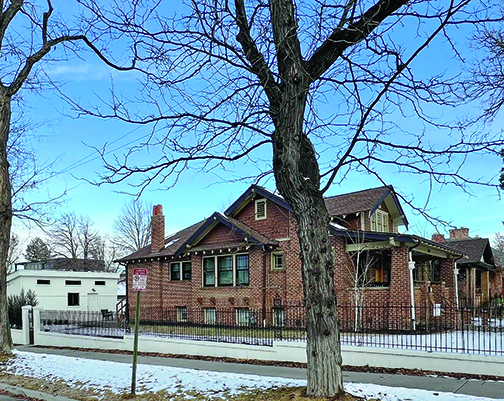
by Heather Brecl | Feb 19, 2024 | Main Articles
by Heather Brecl
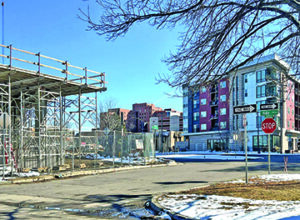
Overdevelopment: Neighbors argue that Hale neighborhood is already stressed by overdevelopment and apartments and does not need more ADUs.
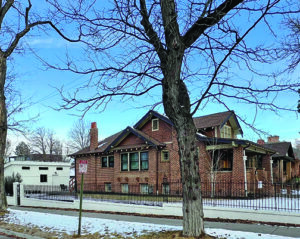
Back To The Future: Denver City Council eliminated Accessory Dwelling Units in 1954. They have raised their ugly head again as seen here at a home in Washington Park.
As the real estate market heats up this Spring, residents in Denver’s Hale neighborhood fear that new proposed rezoning laws regarding ADUs (Accessory Dwelling Units) will further accelerate unwelcome change in the neighborhood they love. And the concerns don’t stop with those residing in Hale — their neighbors in Mayfair, Hilltop, and Crestmoor Park see the impending loosening of regulations as the opening of floodgates for a myriad of problems that will devalue the historic neighborhoods that they hold near and dear to their hearts.
ADUs are a secondary structure or apartment that shares the lot with a larger primary home. They are built to provide additional and separate space for extended family members or to create income as a rental to offset mortgage costs. Often, they are apartments built above a garage, but can also include a finished basement used as separate living quarters. According to the City and County of Denver, Denver Zoning Code no longer has minimum lot size requirements for ADUs, though the size of the property does affect the size of a detached ADU and where on the property it can be.
Controversial District 5 Denver City Councilwoman Amanda Sawyer, a former California resident and CU Boulder grad, (serving Cherry Creek, Country Club, Hale, Hilltop, Lowry, Montclair, Washington-Virginia Vale, and Mayfair) is sponsoring the ADU rezoning efforts. Sawyer is already in hot water with her District 5 constituents over so-called traffic calming measures at 7th and Williams, and other locations which are causing traffic accidents (see Chronicle October 2023 edition’s front page “7th and Williams Fiasco”), and even a recent fatality. Sawyer believes that making ADUs easier to build in Hale will answer some of the affordability challenges that Denver buyers face.
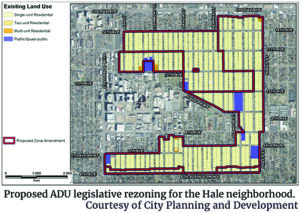
Proposed Rezoning: The areas highlighted in yellow and orange indicate lots subject to ADU redevelopment.
Members of the community in and around Hale see the addition of ADUs through a much different lens. According to residents in the surrounding neighborhoods, making ADUs a more accessible option for all homeowners in the area will destroy the character of their neighborhood and create irreparable damage in addition to the growing pains that are already facing. They fear that ADUs will be used as rentals to offset housing costs, creating a flood of trouble. With the slew of retail, restaurant, and entertainment venues that have been built in the Hale neighborhood near 8th and Colorado in the past few years, along with thousands of new residents that moved into the 9th+CO development, parking and congestion of traffic is already extremely formidable.
One Hale resident, who was granted anonymity to speak freely, has experienced first-hand the nightmare of having to find parking every night by her condo at 11th and Hale, even though she

In Hot Water Again: Councilwoman Amanda Sawyer has stirred controversy once again by pushing the development of ADUs in the Hale neighborhood. Residents of other neighborhoods fear this is just the beginning of pernicious overdevelopment.
owns her own spot. The resident’s designated parking space is rarely available for her own use — recently she parked three blocks away and was robbed at gunpoint returning home from her car. With the congestion and overdevelopment comes a new nine-acre development site with housing that is going in where the old VA Hospital is. Residents have pointed out that there are multiple empty lots where development has stalled, and they have witnessed growing numbers of homeless people.
Many residents believe that the rezoning in Hale isn’t even needed in the neighborhood as there are enough vacant rentals available already. Many feel that most residents probably can’t afford to get a permit for an ADU let alone build it, so there is no reason to change the existing law for the ones who can. They propose that the passing of the measure is simply intended to create a snowball effect for Mayfair and Hilltop next. Of the 16,401 occupied housing units in Hale, 56.81% are owner-occupied, while 43.19% have renters living in them. (Source: point2homes.com). Councilwoman Sawyer confirmed that of those homeowners who qualify to have an ADU on their property, statistically only 1.5% choose to do so. This leads residents to wonder why the money and resources were spent to pass such a measure which affects so few.
Long-time Denver Realtor Denice Reich of Re/Max and area resident voiced grave concerns that the historic integrity of these neighborhoods is in danger with the proposed rezoning that she believes will follow suit in Hilltop and Crestmoor Park once fully approved in Hale. She noted that while the lots in Hale may be too small to fit the guidelines and setbacks required to build an ADU, the larger lots in the neighboring areas are prime territory for ADUs. She fears that what happened in Capitol Hill to a once stately neighborhood with some historic homes being preserved and others scraped and replaced with unsightly multi-family units could happen elsewhere if the legislation continues down this path.
Reich shared that in her experience in residential real estate property, home values drop with the increase of rental units and an

Neighborhood Champion: Denice Reich, Re/Max realtor, is one of the many voices fighting the rezoning efforts of Councilwoman Amanda Sawyer.
increased transient population in the area. In addition, she cited her fear of increased traffic on 13th and 14th Avenues, decreased parking, increased population density, and clogging access for emergency services (especially fire). Furthermore, Reich proposes that there will be detrimental problems stemming from the construction of ADUs near property lines, especially because of the relaxed guidelines for setbacks such as loss of the tree canopy, more non-permeable land for water to flood off, and more noise and dust from construction.
While Councilwoman Sawyer’s Office stands by the results of their community survey in which 58% for expressed support the rezoning for ADUs, while neighbors argue that the number lacks transparency and that the actual sample of those wanting the zoning changes is too small to represent how the overall community truly feels. According to the numbers provided by the Councilwoman’s Office, only 382 responses (representing 4% of the population in Hale) were received and only 212 were considered valid with a margin of error of 6.5%.
It remains to be seen what the overall impact of rezoning will actually be. As the landscape and city continues to change at rapid pace with both the construction of new residential homes and unending commercial development, the conversation continues to escalate leaving all sides seeking long-term solutions that will provide affordable and dependable futures.
The Hale ADU rezoning was passed on January 17, 2024, in a meeting of the Denver Planning Board and then again on February 6, 2024, during the meeting of the LUTI (Land Use, Transportation and Infrastructure) Committee. It will be the subject of a final public hearing with the full City Council scheduled for March 26, 2024. The rezoning will apply to over 1,500 properties.
The public can follow the legislative process and view documents submitted for City Council review at denver.legistar.com or denvergov.org.

by Mark Smiley | Feb 19, 2024 | Main Articles
Lowry’s Latest Attraction Features A Full Menu And Bar And 10 Golf Simulator Bays
by Mark Smiley

Bays Available: Guests can reserve a bay which fits up to eight people for $45 per hour.
The Hangar Club, Denver’s newest indoor golf club, opened two months ago and is thriving in a fiercely competitive market. There are over 30 indoor facilities in Colorado and the Hangar Club hopes to be a step above the competition with its 22,000 square foot venue. They boast an elevated food menu, 36 televisions, a full bar, 10 large bays to practice golf, and state of the art technology.
The way that the Hangar Club separates itself from competitors, such as Local Drive, is “Our differentiation is really our staffing, the group of founders we put together, to make sure we put together the best experience in Colorado, and hopefully the Western United States, as far as indoor golf is concerned,” said Daren Schmidt, Founding Partner of the Hangar Club. “We wanted to give people the best possible experience inside of this building and we feel like we are doing it.”
“The technology is what we call the Ferrari of golf simulations,” said Schmidt. “If you look at any professional golfer or amateur golfer, or anybody that wants to become a great golfer, they use trackman.” Trackman was introduced to the golf world in 2003 and quickly gained popularity among professional golfers. Trackman utilizes Doppler technology to track and record the 3D characteristics of a sports ball in motion. It produces state-of-the-art hardware platforms and delivers improvements across tracking algorithms and front-end applications that are innovative.
The avid golfer can set up a profile and keep track of their swing and statistics. There are 260 courses to choose from in the simulators. “The amount of data this spits out is overwhelming,” said Schmidt. “What our pros do here is we condense the information you get. The average person coming in needs five data points.” The Hangar Club has two professionals on staff to help train and facilitate.

Lounge: Space is available to rent for corporate events, birthday parties, or any other event.
Schmidt and other investors, including James Love, who played professionally for 13 years, bought the property in June 2023 and spent $3.3 Million to renovate it. The hangar was originally built in 1942 and features vast amounts of natural light and open space due to its eight expansive steel beams and large windows used in the building’s original construction.

Menu: The Hangar Club features an elevated menu with finger foods, sandwiches, and pizzas.
Previously referred to as Building #376 (Armament Annex) and added to the National Register of Historic Places in 2002, the building originally functioned as part of the armament school for the U.S. Army Air Corps and later the U.S. Air Force, the only one of its kind in the western United States. It trained thousands of armorers and bombardiers during World War II and the Korean War, including training on the Sperry bombsight and the top secret Norden bombsight, a key technology for winning the war.
Fast forward to today, Schmidt is proud to own a building on the base where his father was inducted into the Air Force. “I called dad who has now since retired and told him I’m buying this building in Lowry and he said that’s where I was inducted into the Air Force,” said Schmidt. “He remembered the building and was there when it was dirt roads and an Air Force base.”
Schmidt and the other investors are proud to be part of the fabric of the Lowry community. “We created a number of fillers we wanted associated with this, given that we own the real estate,” said Schmidt. “We are proud owners in the Lowry neighborhood. Community is number one and the beauty of the Lowry area is it is surrounded by other neighborhoods such as Cherry Creek and Mayfair. We wanted this to be a space where families could come, where avid golfers could come, and ultimately anybody and everybody who has either never played golf before or wants to be exposed to it, or the avid golfer to work on their game.”
From the avid golfer looking to perfect their skills to the casual friendly gathering of executives who want a different way to conduct business, Hangar Club combines work and play to provide an elevated experience and best-in-class service to all who walk through its doors.
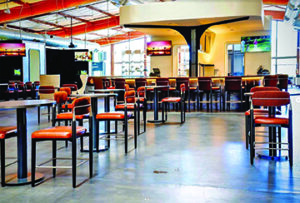
Full Bar: The Hangar Club features a full bar and is open from 11 a.m. to 11 p.m. every day.
Part of the elevated experience that the Hangar Club touts is the menu. “The whole concept was if you are going to be swinging a golf club, you don’t want a greasy cheeseburger and French fries,” said Schmidt. “We have great finger foods and sandwiches and tuna plates. We have everything from queso and guacamole and flatbreads. The intent was for people to have an elevated and premiere menu that you wouldn’t necessarily get at another simulator place.”
Hangar Club is located adjacent to Wings Over the Rockies Air & Space Museum at 7600 E. 1st Place in Denver. The club’s entrance is on the east side of the building. Surface and covered parking are both available.
The Hangar Club opens at 6 a.m. for members and to the public at 11 a.m. and closes at 11 p.m. each day. During the week, a guest can reserve a bay for $45 per hour from 11 a.m. to 5 p.m. Eight people can fit in each bay. Visit hangarclub.co for more information.

by Valley Gadfly | Jan 19, 2024 | Main Articles
Ten New Projects To Convert Cherry Creek’s 16-Blocks Into Colorado’s Top Urban Community By The End Of Decade
by Glen Richardson

Changing Cherry Creek: Here’s what architects- developers are proposing for the former Sears store site at 2nd Ave. & Adams. Demolition is set to begin April 1. Completion is anticipated as soon as the third quarter of 2025.
The push to build new office, retail, and apartment projects in Cherry Creek North as 2024 gets underway is unlike anything the district has ever seen. Construction is set to experience its best year on record, with developers launching 10 projects as the new year begins.
The latest construction boom, moreover, mostly ignores the $1 billion Cherry Creek West mall project, though it is inching closer to reality along University Blvd. Construction at that site isn’t scheduled to start until at least the third quarter of 2024, with the first building not ready for occupancy until 2027. A gargantuan development, nonetheless, authorities say the project will create 50% of new Cherry Creek Valley jobs and 30% of new households through the year 2040.
This year’s construction ricochet will likely push the district into becoming the new epicenter of the Mile High City, as downtown continues to struggle. For several years now, companies have established offices or headquarters in Cherry Creek, increasingly solidifying the district as the Mile High City’s hub.
Mixed Use Move
As businesses add more space along the district’s 16 blocks, this much is clear: Once simply a shopper’s haven, developers are converting the neighborhood into a live, work, and play destination. Moreover, due to crime and homelessness issues downtown, more travelers are choosing to stay in Cherry Creek-Glendale hotels.
While more of a mixed-use district, the area nevertheless has developers once again adding retail space to the latest Cherry Creek projects.
The district’s thriving office market, as expected, remains one of the nation’s best. The latest construction trend suggests an increase rather than slackening in office demand.
Schnitzer Eight-Story
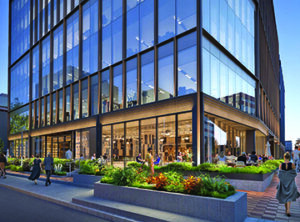
Swift Schnitzer Start: Expected to be completed by the third quarter of 2025, Schnitzer West, LLC, broke ground at 201 Fillmore on this eight-story building on Nov. 4, 2023.
Schnitzer West, LLC, broke ground back on Nov. 4, 2023, at 201 Fillmore on an eight-story building it expects to complete by the third quarter of next year (2025).
The building’s 130,000-sq.-ft. of office space on seven floors will house one of Colorado’s largest independent oil and gas firms. Antero Resources is currently headquartered near Union Station on Wynkoop St. The 8,600-sq.-ft. of ground floor retail space will feature a restaurant, plus another eatery is tentatively taking the rooftop terrace.
The development will have five levels of below-grade parking, with 250 spaces for office and retail use. There will be secure loading docks for tenant’s use.
Scraping Sears Site
One of the largest and definitely Cherry Creek’s longest anticipated, demolition of the Sears Building at 2nd Ave. & Adams is set to begin April 1. The site will be replaced with a blend of office and retail spaces in a five-story package. Like the 201 Fillmore project, completion is probable by the third quarter of 2025 albeit more likely by year’s end. The 90,000-sq.-ft. site will feature a mix of masonry, steel, and glass.
With the Crate & Barrel building, size of the parcel totals 9.4 acres. According to plans, the Crate & Barrel building will be demolished down to grade level, though the parking garage will remain. It will be replaced with a new five-story mixed-use residential-apartment building. BMC Investments CEO Matt Joblon is working with Crate & Barrel on relocation to a new temporary or permanent space, possibly within the site.
Broe Building Bulge
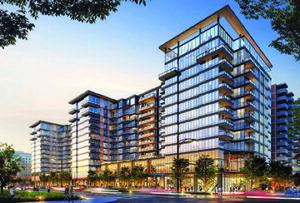
Broe Buildup: In addition to launching an eight-story office project on Clayton this month, Broe wants to demolish its 10-story 50 S. Steele St. office site and build this 12-story, 378-unit apartment building with ground floor retail.
Broe Real Estate Group — the multi-billion-dollar developer headquarters on Clayton St. in Cherry Creek — is beginning the second phase of its office redevelopment project by launching an eight-story, 175,000-sq.-ft. mixed use office project at 250 Clayton. Completion is anticipated in early 2026. Tenants will have access to floorplates as large as 27,000-sq.-ft. The site will also include retail space. Broe plans to later demolish the parking garage and building at 252 Clayton St., and build another seven-story office building there.
Broe has also asked to demolish the site of its 10-story office building at 50 S. Steele St. They seek to build a 12-story, 478-unit apartment complex with ground floor retail across from the eastern end of the Cherry Creek Shopping Center.
As 2023 closed, Broe purchased the 587-unit Seasons of Cherry Creek apartment complex on E. Ellsworth Ave. One of the largest real estate transactions in Cherry Creek history, Broe paid $225 million. The 480-unit complex is spread across three buildings on 5.2 acres.
Betwixt & Between
Plotting to build on every plot, Alpine Investments will erect a mixed-use office- retail building on a 0.57-acre site at 2645 E. 2nd Ave. between the Cherry Cricket and the Clayton Hotel & Members Club.
Development of the site will require the demolition of the one-story rear portion of the Cherry Cricket, where restrooms are located. The front of the restaurant building along E. 2nd Ave. will remain. The office building will include three levels of below-grade parking plus ground-floor retail space.
The two-story portion that currently houses Cherry Creek Tailoring & Alterations and cocktail bar Forget Me Not, however, will be bulldozed.
More From BMC
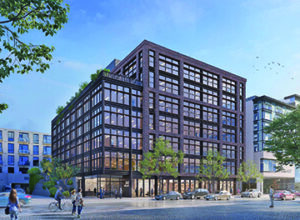
Major Housings: BMC Investments is building an eight-story major league apartment complex at Milwaukee and 3rd Ave. The structure will feature 30,000-sq.-ft. of ground floor retail.
In addition to the Sears building site, MBC Investments is breaking ground on two projects along Milwaukee Street as 2024 begins. One of Cherry Creek’s most active-successful developers, BMC is adding a seven-story mixed-use project at 242 Milwaukee St. It will feature 84,000-sq.-ft. of office space and 10,000-sq.-ft. of retail plus 202 parking spaces.
On the corner of 3rd Ave. and Milwaukee, an eight-story apartment structure is being erected. It will have 156 luxury units plus 30,000-sq.-ft. of ground floor retail. Being designed for those seeking a moderate-sized floorplan, units will average 885-sq.-ft. The site will include studios, junior one-bedrooms, and two-bedroom plus den units.
A rooftop pool, outdoor grilling area, fire pit, and dining area are planned. More: Sauna, co-working areas, meeting rooms, and bike repair shop are included. A resident lounge and parking garage will also be built.
A Pair On 2nd Ave.

Cricket Or Not: Alpine Investments is erecting this office-retail building on an 0.57-acre site between the Cherry Cricket and the Clayton Hotel & Members Club at 2647 E. 2nd Ave.
Residents have come to expect Cherry Creek to be in constant change. However, that hasn’t been the case for a trio of projects a block apart on the south side of 2nd Ave. For at least two — at 2nd and Steele and 2nd and St. Paul — construction is set to break ground. A lot directly east of the Cherry Creek Grill at 2nd and Adams has sat empty for two years. Owned by Bow River Capital’s Blair Richardson, it was first proposed as offices and later a five-story condo site. Construction remains unlikely.
Directly across Steele Street from the Grill, where Patxi’s Pizza closed a year ago and Bloom by Anuschka does business, a five-story, 37 condo development will be built. The $50-million project will have 3,532-sq.-ft. of ground-floor retail and 4,360-sq. ft. of restaurant space. There will also be a 75-space underground garage.
A block further west at 190 St. Paul St. —where Italian restaurant Piatti has sat empty since Christmas of 2021 — a five-story, 272,000-sq.-ft. condo project will be built by luxury brand Waldorf Astoria. The site will have a 5,360-sq.-ft. restaurant and 3,532-sq.-ft. of retail plus a 70-space underground parking garage.
Space On Cook
Dallas-based Mill Creek Residential is breaking ground on a six-story, 110 Apartment complex on the southwest corner of 2nd Ave. and Cook Street (155 & 165 Cook St.). The structure is replacing a pair of three-and-four-story office buildings. Completion is expected in early 2025.
Rough Road Ahead
The impressive growth proposed and promoted with Cherry Creek’s latest developments is certain to create transportation, traffic congestion, and parking problems. Residents living in the neighborhood care about the district’s future, and want to maintain the quality of life and success they now enjoy.
The attraction of businesses and their office space needs has accelerated the desire of certain businesses to move to Cherry Creek from other areas of the city. Actual development has already exceeded the 10-year forecasts.
Next month the Chronicle will look at Cherry Creek’s first major analysis of BID’s growth and development. The report offers tough recommendations that need to be made before it is too late to make a difference.































